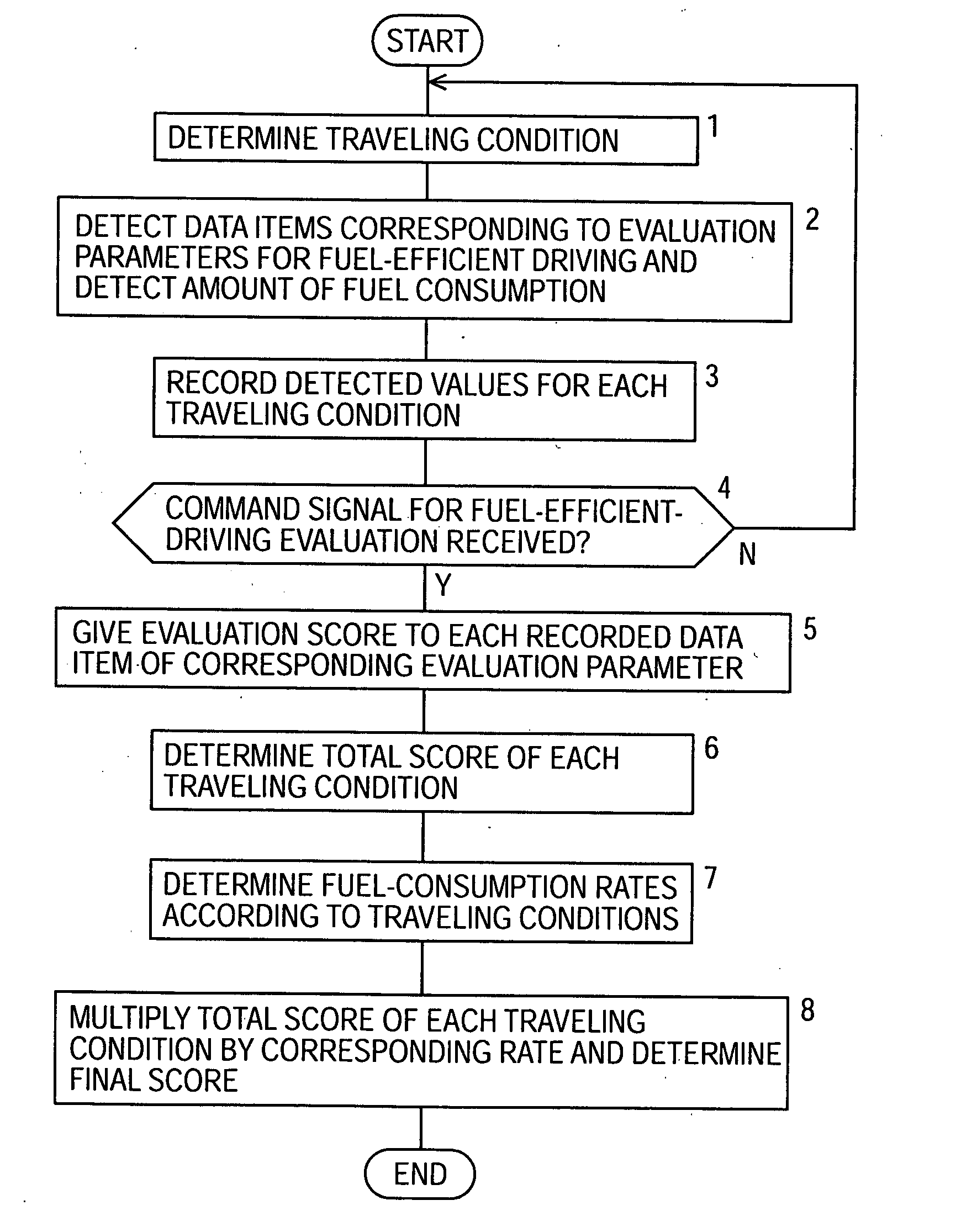Fuel and method for evaluating fuel saving operation
a fuel-saving operation and evaluation method technology, applied in the direction of electric control, machines/engines, instruments, etc., can solve the problems of not always appropriate evaluation in view of fuel-saving driving, greatly affected delivery costs, and inability to evaluate fuel-saving driving. to achieve the effect of fuel efficiency
- Summary
- Abstract
- Description
- Claims
- Application Information
AI Technical Summary
Benefits of technology
Problems solved by technology
Method used
Image
Examples
first embodiment
[0034]FIG. 2 illustrates a fuel-efficient-driving evaluator according to a first embodiment of the present invention. Some reference numerals correspond to those in FIG. 6. Reference numeral 41 indicates a first storage portion, reference numeral 42 indicates a second storage portion, reference numeral 4N indicates an N-th storage portion, reference numeral 51 indicates a first evaluating portion, reference numeral 52 indicates a second evaluating portion, reference numeral 5N indicates an N-th evaluating portion, reference numeral 61 indicates a first totalizing portion, reference numeral 62 indicates a second totalizing portion, reference numeral 6N indicates an N-th totalizing portion, reference numeral 7 indicates a correction totalizing unit, and reference numeral 11 indicates a correction-coefficient providing unit.
[0035] The components that are given the same reference numerals as those in FIG. 6 are the same components, and the descriptions of such components will thus be o...
second embodiment
[0059]FIG. 3 illustrates the fuel-efficient-driving evaluator according to a second embodiment of the present invention. Some reference numerals correspond to those in FIGS. 2 and 6. Reference numeral 81 indicates a first correcting portion, reference numeral 82 indicates a second correcting portion, and reference numeral 8N indicates an N-th correcting portion.
[0060] The second embodiment is different from the first embodiment in that the evaluation scores in each traveling condition are corrected before they are totalized. (In the first embodiment, the evaluation scores in each traveling condition are corrected after they are totalized. In other words, the correction process and the totalizing process are performed in an opposite order.) Consequently, a correcting unit 8 is provided in a position following the evaluating unit 5, and the totalizing unit 6 is provided in a position following the correcting unit 8. The correcting unit 8 includes a first correcting portion 81 to an N...
third embodiment
[0063]FIG. 5 illustrates the fuel-efficient-driving evaluator according to a third embodiment of the present invention. Some reference numerals correspond to those in FIG. 3, and reference numeral 9 indicates a timekeeper. In the third embodiment, instead of detecting the amount of fuel consumption, the time spent in each traveling condition is measured in order to determine the rate of fuel consumption for each traveling condition.
[0064] The timekeeper 9 measures the time spent in each of the traveling conditions. The measured time in each traveling condition is recorded individually onto the storage unit 4 (one of T1 to TN). For example, the time spent in the first traveling condition is recorded onto the storage portion corresponding to the first traveling condition, i.e. the first storage portion 41.
[0065] To determine the rate of fuel consumption based on the time spent in one of the traveling conditions, the average amount of fuel consumption in the traveling condition (that...
PUM
 Login to View More
Login to View More Abstract
Description
Claims
Application Information
 Login to View More
Login to View More - R&D
- Intellectual Property
- Life Sciences
- Materials
- Tech Scout
- Unparalleled Data Quality
- Higher Quality Content
- 60% Fewer Hallucinations
Browse by: Latest US Patents, China's latest patents, Technical Efficacy Thesaurus, Application Domain, Technology Topic, Popular Technical Reports.
© 2025 PatSnap. All rights reserved.Legal|Privacy policy|Modern Slavery Act Transparency Statement|Sitemap|About US| Contact US: help@patsnap.com



